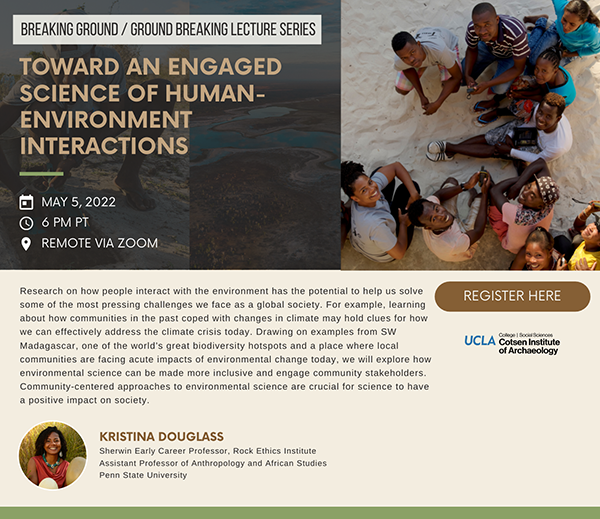Past Events
Interested in Cotsen events? Sign up for our mailing list.Speaker: 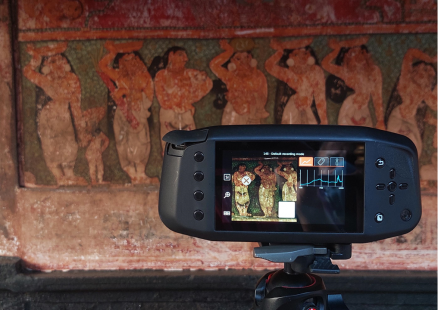
Moupi Mukhopadhyay
Ph.D. Student
UCLA Conservation of Material Culture IDP
Abstract: The wall paintings in the Indian state of Kerala belonging to the Kerala mural tradition (7th - 17th century CE) provide important cross-cultural links that contextualize local historical religious practices, trade, and social interactions. The complex color scheme of the paintings is traditionally attributed to the skillful use of only five colors (panchavarna) – black, red, yellow, green and white. However, the available literature on the technical study of the murals does not consistently assign the same material (coloring agent or pigment) to the composition of a single color. For example, while black is generally accepted as lamp black across different publications, the green has been ascribed to green earth, powdered leaves, or combinations of yellow ochre, gamboge, indigo, and even lapis lazuli. Understanding the materials used in specific temple murals, and their possible sources, can help better understand the nature and movements of the agents involved in the creation of these paintings. Advances in material characterization methods have significantly increased the scope of identifying the composition of the colors in murals non-invasively, ideal for the preliminary research required to build a case for a more intensive technical study. Non-invasive fieldwork was conducted on selected temples in Kerala, using a digital single-lens reflex camera (DSLR) for photography as well as Infrared (IR) imaging, and a SPECIM IQ hyperspectral camera for hyperspectral imaging (HSI). Permissions to access the temples allowed for the use of only sunlight as the illumination source, adding to the complexity of the interpretation of the data obtained. The use of Infrared False Color Imaging (IRFC) in conjunction with the analysis of HSI data reveals photophysical characteristics of the pigments which are useful for their identification, and for determining optimal characterization methods for further scientific investigation.
Bio: Moupi Mukhopadhyay is a PhD Candidate in the Conservation of Material Culture Program IDP at UCLA. She is interested in investigating the photophysical and chemical properties of pigments in cultural heritage materials using scientific techniques, to better inform their conservation. Through her research, she aims to develop a better understanding of the materials and technology of the creation of temple wall paintings in Kerala, India.
Contact Sumiji Takahashi
Email sutakahashi@ioa.ucla.edu
Phone 310-825-4169
Phidias Unbound: How Robot-Generated Replicas Could Solve the Parthenon Marbles Quandary
Roger Michel
Executive Director, The Institute for Digital Archaeology
Please submit your questions in advance of the webinar via email to:
hnadworny@support.ucla.edu by Wednesday, October 12 at 12:00 p.m.
Instructions to join the webinar will be provided once your registration
has been confirmed.
About the program:
The Parthenon Marbles, commonly known as the Elgin Marbles, were removed from the ancient Acropolis of Athens in 1801 by Lord Elgin, British ambassador to the Ottoman Empire. Carved by the sculptor Phidias, they were eventually sold to the British government in 1817 and are housed in the British Museum. Public debate about repatriating the marbles is heated and ongoing.Can the creation of exact copies of the originals resolve the repatriation quandary? Roger Michel, executive director of the Institute of Digital Archaeology, at the University of Oxford, believes the repatriation issue can be resolved with the help of 3-D machining. His research team has developed a robot with the ability to create faithful copies of large historical objects. Michel will explore humanity’s connection to culturally significant objects and the emphasis we place on physical possession. Is possession an inherently colonial concept? Are heritage assets particularly susceptible to being exploited for the purposes of historical revisionism? Under what circumstances can copies provide satisfactory substitutes for original material? These questions will be examined against the backdrop of the IDA’s ongoing Elgin repatriation efforts.
About the speaker:
Roger Michel is the founder and Executive Director of the Institute for Digital Archaeology (IDA). The IDA operates globally, undertaking a huge variety of heritage projects, many of which are aimed at advancing social justice goals. Its principal partners are the UN, UNESCO and local and national governments. Mr Michel has published and lectured frequently on various heritage conservation topics. He was a member of the faculty at BU Law School for 25 years, is an Honorary Fellow of Trinity College (Oxford), and is co-publisher of Arion Magazine. Mr Michel is a graduate of Harvard and Oxford Universities.
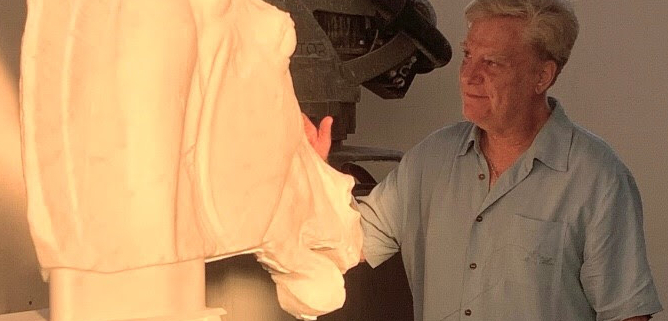
https://conservation.ucla.edu/event/phidias-unbound-how-robot-generated-...
Contact
Phone
In person followed by pizza
Dr. Matthew Robb (chief curator of the Fowler) gave a private tour consisting of in-depth responses to student questions.
Contact
Phone
The Cotsen Institute of Archeology Press invites you to the latest Author Spotlight with
Stephen Dueppen
Associate Professor, Department of Anthropology
University of Oregon
Mounded sites (tells) are common throughout West Africa, including in western Burkina Faso where clusters of mounds dating to the past three millennia are common. Extensive fieldwork at the long inhabited and well-preserved site of Kirikongo (ca. 100—1650 AD), has established that the community started as a small farming settlement, grew to a large community centered on the village’s founders, rejected inequalities in an egalitarian revolution, and survived the Black Death pandemic. This talk explores patterns in architecture, material culture and organic remains (animal bones and botanical remains) to argue that the mounds at Kirikongo are not only residential, but also stratified ancestor shrines whose ritual deposits inform on the divine associations of different houses in a ritual landscape.

Contact Michelle Jacobson
Email mjacobson@ioa.ucla.edu
Phone
Dr. Zoila Mendoza
Department of Native American Studies, UC Davis
Tuesday May 24th, 3pm PT

Contact Elyse Brusher
Email ebrusher@ucla.edu
Phone
Claudio Cancino
Architect, Architectural Conservator | MBA | MS
Senior Project Specialist, Building and Sites department, Getty Conservation Institute
The community of Kuñotambo, a small village near Cusco, Peru has been a crucial and significant stakeholder for the conservation of its church of Santiago Apóstol. Thanks to them, their church was seismically retrofitted and is now maintained as a case study for similar sites in the region.
The church is one of the four case studies of the Seismic Retrofitting Project, a collaborative project between the Getty Conservation Institute and the Ministry of Culture of Peru. The SRP aims to design, test and model seismic retrofitting techniques suitable to earthen buildings using low-tech materials and local expertise.
The construction documents for the seismic retrofitting of the church were developed by the GCI and the Ministry of Culture of Cusco; where the SRP designed retrofitting techniques were implemented. The construction phase started in 2016 and the church was inaugurated in 2019.
This contribution will explain the importance of the involvement of local communities for the conservation and maintenance of their heritage.
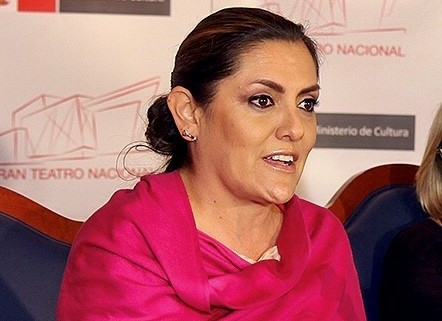 Claudia Cancino is a licensed architect from Peru and manages the Getty Conservation Institute Earthen Architecture Initiative which has three components: The Seismic Retrofitting Project in Peru, the Earthen Architecture Course in Al-Ain, Abu Dhabi and the Terra 2021 Congress in Santa Fe, New Mexico. She also manages the Retrofitting and Repair Component of the Bagan Conservation Project. She earned a certificate in conservation at ICCROM in Rome, followed by graduate diploma in business administration at ESAN in Lima. She practiced preservation architecture and has taught Earthen Conservation at several universities. She earned a Master of Science in Historic Preservation and an advanced certificate in conservation from the University of Pennsylvania.
Claudia Cancino is a licensed architect from Peru and manages the Getty Conservation Institute Earthen Architecture Initiative which has three components: The Seismic Retrofitting Project in Peru, the Earthen Architecture Course in Al-Ain, Abu Dhabi and the Terra 2021 Congress in Santa Fe, New Mexico. She also manages the Retrofitting and Repair Component of the Bagan Conservation Project. She earned a certificate in conservation at ICCROM in Rome, followed by graduate diploma in business administration at ESAN in Lima. She practiced preservation architecture and has taught Earthen Conservation at several universities. She earned a Master of Science in Historic Preservation and an advanced certificate in conservation from the University of Pennsylvania.
Contact Céline Wachsmuth
Email wachsmuthc@g.ucla.edu
Phone
You are cordially invited to The Vishap: From Fairy Tale to Reality (click on link for schedule)
Sunday May 15th, 2022 at 2:00 - 6:00pm PDT
The Narekatsi Chair in Armenian Studies presents "The Vishap: From Fairy Tale to Reality," by Dr. Arsen Bobokhyan. This event is co-sponsored by the Promise Armenian Institute, the Ararat-Eskijian Museum, and the National Association for Armenian Studies & Research with the participation of the Research Program in Armenian Archaeology and Ethnography at the Cotsen Institute of Archaeology and the Institute for Archaeology and Ethnography of the Armenian Academy of Sciences.
2:00 - 3:30 PM Royce Hall 314
Illustrated Lecture on documenting and preserving the dragon-stones of Armenia from the 2nd millennium BCE by Dr. Arsen Bobokhyan (PI of this project and Director of the Institute of Archaeology and Ethnography in Yerevan), followed by a documentary of the dragon-stones and the initial phase of their investigation and restoration.
3:30 - 6:00 PM Powell Rotunda
Presentation of Dr. Bobokhyan's latest monograph Atrpet’s “Scientific Adventures” and Discovery of the Vishap Stelae (in Armenian), followed by a guided tour of an exhibit of thirty high-resolution images of the dragon-stones by Dr. Bobokhyan and recital by the UCLA Armenian Ensemble. The event will conclude with a Wine and Cheese Reception.
The event will livestream on the Ararat-Eskijian Museum's Facebook and YouTube pages.
 Arsen Bobokhyan is Directory of the Institute for Archaeology and Ethnography of the Armenian Academy of Sciences. He received his Ph.D. from the Institute of Prehistory at the University of Tuebingen (2008) and has since been an Asst. Professor of History at Yerevan State University and Lecturer at the American University of Armenia. The author of three books and over a hundred articles, he has served as editor of a number of scholarly journals and has been invited as visiting professor at several universities in the German-speaking world. His research interests include the early Archaeology of the Armenian Plateau and the Caucasus, the Near East and Asia Minor, Cultural Relations, Ancient Barter and Weight Systems and Religion and Cult.
Arsen Bobokhyan is Directory of the Institute for Archaeology and Ethnography of the Armenian Academy of Sciences. He received his Ph.D. from the Institute of Prehistory at the University of Tuebingen (2008) and has since been an Asst. Professor of History at Yerevan State University and Lecturer at the American University of Armenia. The author of three books and over a hundred articles, he has served as editor of a number of scholarly journals and has been invited as visiting professor at several universities in the German-speaking world. His research interests include the early Archaeology of the Armenian Plateau and the Caucasus, the Near East and Asia Minor, Cultural Relations, Ancient Barter and Weight Systems and Religion and Cult.
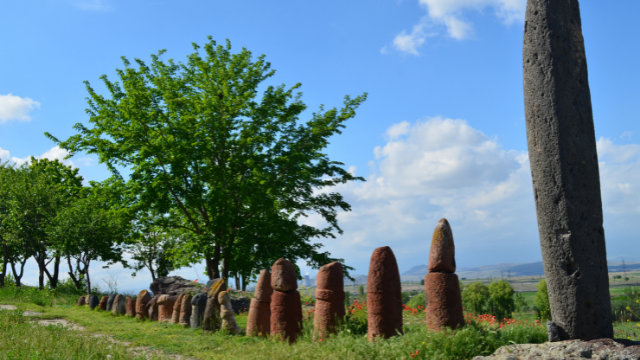
Vishapakar (Photo: Sonashen via Wikimedia Commons, 2013; cropped. CC BY-SA 3.0)
Contact Kristine Martirosyan-Olshansky
Email kristineolsh@ucla.edu
Phone
Jeremy Mikecz
Neukom Institude Postdoctoral Fellow
Native American Studies, Darmouth University
In-person, Digital Archaeology Lab, Fowler A163
Thursday May 12th, 2022 from 10am-1pm PT
Data visualizations and mapping carry with them some baggage. Graphs lie. Maps hide. Politicians, corporations, and others use them to persuade (at best), or deceive or divide (at worst). However, just as the earliest maps were simply tools intended to help us locate our place in the world, qualitative, humanistic visualization allows us to more systematically interrogate historical narratives, construct alternative narratives, and compare the difference between the two. In this hands-on workshop, Dr. Jeremy Mikecz introduces participants to inspiring examples of visualizations that reveal rather than conceal human stories. He also offers a tutorial demonstrating simple methods for producing similar visualizations in the free, open-source program Inkscape. Participants will have the opportunity to create their own qualitative, humanistic, or narrative visualization by the end of the workshop.
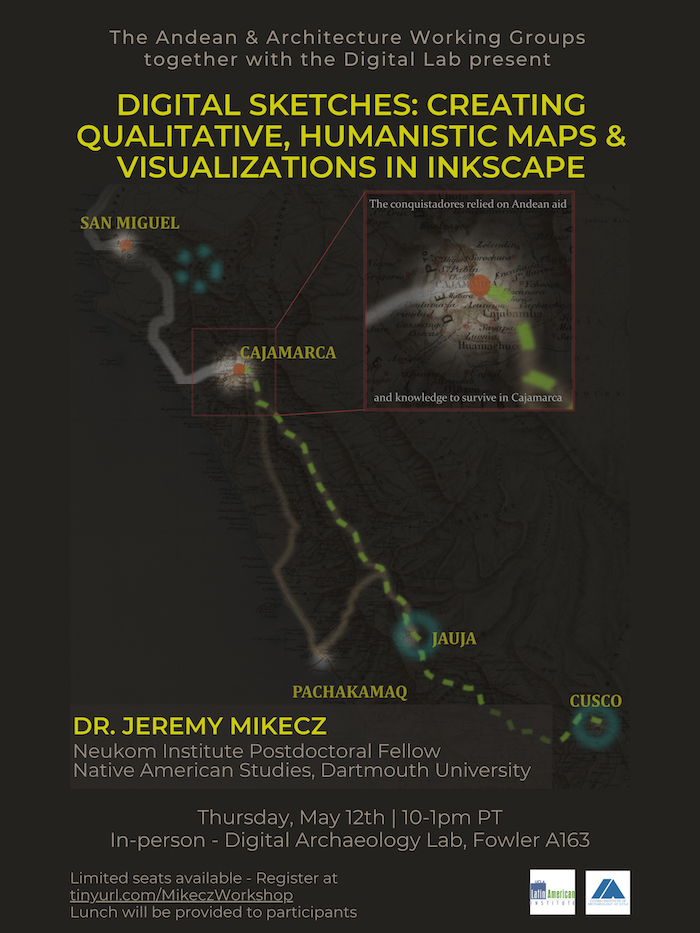 Sponsored by the Cotsen Institute of Archaeology and UCLA Latin American Institute
Sponsored by the Cotsen Institute of Archaeology and UCLA Latin American Institute
Contact Alba Menéndez Pereda & Rachel Schloss
Email albamenendez@ucla.edu & rachelschloss@g.ucla.edu
Phone
Jeremy Mikecz
Neukom Institude Postdoctoral Fellow
Native American Studies, Darmouth University
Wednesday May 11th, 2022 at 4pm PT
Register here (Link for both in-person and Zoom attendance)
How can patterns embedded in historical texts be made visible? How can we map texts and visualize narratives? How does doing so allow us to confront historical silences and challenge scholarly erasures in new and productive ways?
In this presentation, the historian Dr. Jeremy Mikecz will discuss how he answers these questions through the integration of digital mapping and qualitative visualization as well as the close reading of Spanish and Indigenous texts. In doing so, he will show how qualitative, humanistic, and narrative visualization can complement more traditional ethnohistorical approaches to historical recovery. His talk will explore his work on two separate, but related research projects. First, he will describe how he develops or adapts new methods, borrowed from experimental cartography, literary geography, and even data science, to re-imagine the Spanish invasion of the Inka Andes (1530s AD). Drawing from his forthcoming book, Mapping Conquest, Mikecz recovers an alternative history of the so-called “conquest” by rendering the gaps and silences of colonial texts visible, thus showing what colonial authors worked hard to conceal. It then fills in those gaps by tracing and mapping Indigenous activity—as recorded in Indigenous texts—thus re-animating the contributions of Andean actors to the creation of the colonial world. In doing so, it shows how long-term Indigenous histories, politics, and geographies shaped events of the period in ways that Spanish authors could not comprehend.
Second, Mikecz will share his preliminary efforts to create a digital "database" of some of the most foundational historical texts written in or about the Andes of the 16th and 17th centuries. Digitizing and encoding these texts using xml will then allow them to be searched and queried in sophisticated ways. The goal is to post this searchable text corpus or "database" online for use by students and scholars in the Americas and beyond.
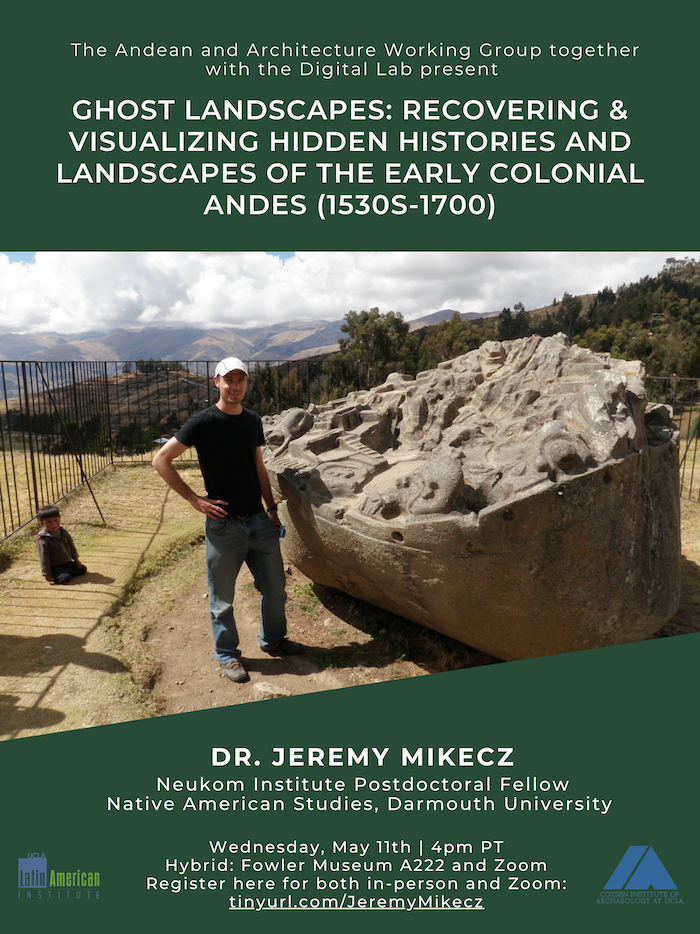
Sponsored by the Cotsen Institute of Archaeology and UCLA Latin American Institute
Contact Alba Menéndez Pereda & Rachel Schloss
Email albamenendez@ucla.edu & rachelschloss@g.ucla.edu
Phone
Kristina Douglass, Sherwin Early Career Professor in the Rock Ethics Institute and Assistant Professor of Anthropology and African Studies
Research on how people interact with the environment has the potential to help us solve some of the most pressing challenges we face as a global society. For example, learning about how communities in the past coped with changes in climate may hold clues for how we can effectively address the climate crisis today. Drawing on examples from SW Madagascar, one of the world’s great biodiversity hotspots and a place where local communities are facing acute impacts of environmental change today, we will explore how environmental science can be made more inclusive and engage community stakeholders. Community-centered approaches to environmental science are crucial for science to have a positive impact on society.
Kristina Douglass
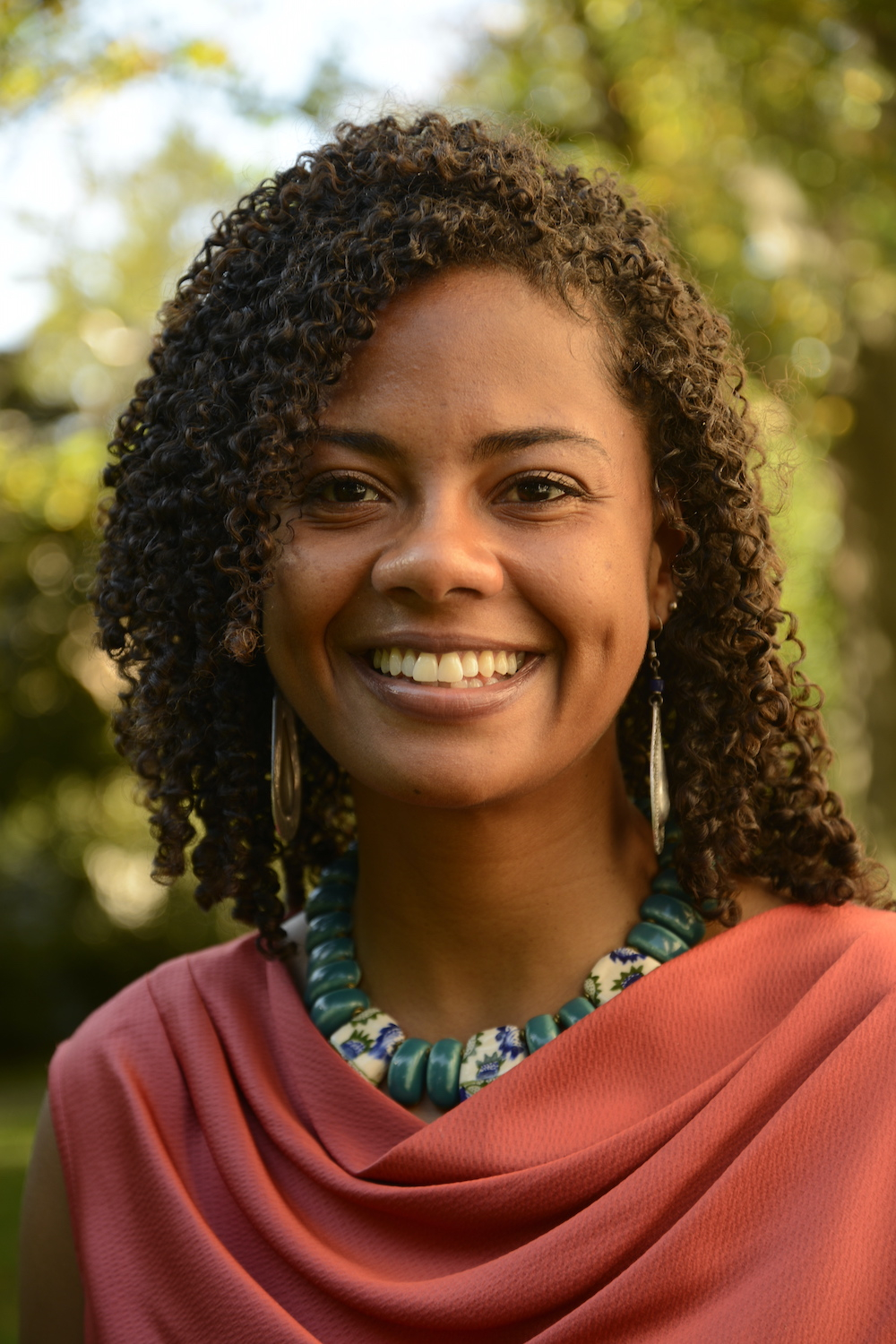 Kristina Douglass is an archaeologist who investigates how people, land-and seascapes co-evolve. She is the Joyce and Doug Sherwin Early Career Professor in the Rock Ethics Institute and Assistant Professor of Anthropology and African Studies at Penn State University. Sheis a Penn State Institutes for Energy and the Environment co-funded faculty member and a faculty affiliate of the Institute for Computational and Data Sciences. Douglass is also a Smithsonian Institution Research Associate. Her work is grounded in collaborations with local, Indigenous, and descendant (LID) communities as equal partners in the co-production of science, and the recording, preservation and dissemination of LID knowledge. Douglass and her collaborators aim to contribute long-term perspectiveson human-environment interactions to public debates, planning and policymaking on the issues of climate change, conservation, and sustainability. Since 2011 Douglass has directed the Morombe Archaeological Project (MAP), based in the Velondriake Marine Protected Area. This territory is home to diverse LID communities, including Vezo fishers, Mikea foragers and Masikoro herders. The MAP team is made up of Velondriake LID community members, and an international group of graduate students and postdoctoral researchers. The MAP is anchored at Penn State to the Olo Be Taloha Lab (@OBTLab andhttps://obtlab.la.psu.edu) for African Environmental Archaeology, which Douglass also directs. Douglass is a mother, singer, dancer, Capoeirista, SCUBA diver and avid gardener, all of which intersect in essential ways with her work as an archaeologist.
Kristina Douglass is an archaeologist who investigates how people, land-and seascapes co-evolve. She is the Joyce and Doug Sherwin Early Career Professor in the Rock Ethics Institute and Assistant Professor of Anthropology and African Studies at Penn State University. Sheis a Penn State Institutes for Energy and the Environment co-funded faculty member and a faculty affiliate of the Institute for Computational and Data Sciences. Douglass is also a Smithsonian Institution Research Associate. Her work is grounded in collaborations with local, Indigenous, and descendant (LID) communities as equal partners in the co-production of science, and the recording, preservation and dissemination of LID knowledge. Douglass and her collaborators aim to contribute long-term perspectiveson human-environment interactions to public debates, planning and policymaking on the issues of climate change, conservation, and sustainability. Since 2011 Douglass has directed the Morombe Archaeological Project (MAP), based in the Velondriake Marine Protected Area. This territory is home to diverse LID communities, including Vezo fishers, Mikea foragers and Masikoro herders. The MAP team is made up of Velondriake LID community members, and an international group of graduate students and postdoctoral researchers. The MAP is anchored at Penn State to the Olo Be Taloha Lab (@OBTLab andhttps://obtlab.la.psu.edu) for African Environmental Archaeology, which Douglass also directs. Douglass is a mother, singer, dancer, Capoeirista, SCUBA diver and avid gardener, all of which intersect in essential ways with her work as an archaeologist.
Contact Michelle Jacobson
Email mjacobson@ioa.ucla.edu
Phone
- ‹ previous
- 12 of 50
- next ›
